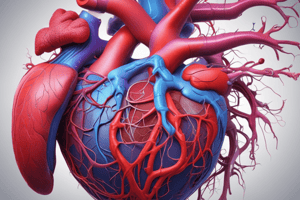Podcast
Questions and Answers
What role do the chordae tendineae play during the contraction of the right ventricle?
What role do the chordae tendineae play during the contraction of the right ventricle?
- They open the tricuspid valve.
- They close the aortic semilunar valve.
- They support the contraction of the left ventricle.
- They prevent inversion of the tricuspid valve. (correct)
Why is the wall of the left ventricle thicker than that of the right ventricle?
Why is the wall of the left ventricle thicker than that of the right ventricle?
- To facilitate faster heart rate.
- To enable stronger contractions for systemic circulation. (correct)
- To accommodate larger blood volume.
- To support lower blood pressure.
What function does the fibrous skeleton of the heart serve?
What function does the fibrous skeleton of the heart serve?
- It anchors the valve flaps and prevents overstretching. (correct)
- It ensures the ventricles contract simultaneously.
- It creates electrical impulses in the heart.
- It increases the heart rate during exercise.
What happens to the aortic valve when the left ventricle relaxes?
What happens to the aortic valve when the left ventricle relaxes?
Which statement accurately describes the relationship between the mitral valve and chordae tendineae?
Which statement accurately describes the relationship between the mitral valve and chordae tendineae?
What is the primary function of the mitral valve?
What is the primary function of the mitral valve?
Which hormone is produced by the atria in response to increased blood volume?
Which hormone is produced by the atria in response to increased blood volume?
What effect does atrial natriuretic peptide (ANP) have on the kidneys?
What effect does atrial natriuretic peptide (ANP) have on the kidneys?
What happens when the right ventricle contracts?
What happens when the right ventricle contracts?
Which structure prevents the backflow of blood into the right ventricle during relaxation?
Which structure prevents the backflow of blood into the right ventricle during relaxation?
What is the role of the chordae tendineae in the heart?
What is the role of the chordae tendineae in the heart?
Which hormone serves as an antagonist to aldosterone?
Which hormone serves as an antagonist to aldosterone?
What is the primary purpose of the pulmonary semilunar valve?
What is the primary purpose of the pulmonary semilunar valve?
What role do the papillary muscles and chordae tendineae play in heart function?
What role do the papillary muscles and chordae tendineae play in heart function?
Which chamber of the heart is responsible for pumping oxygenated blood to the body?
Which chamber of the heart is responsible for pumping oxygenated blood to the body?
What is the primary function of the aortic semilunar valve?
What is the primary function of the aortic semilunar valve?
Where do the right and left coronary arteries branch from?
Where do the right and left coronary arteries branch from?
Which layer of the heart primarily consists of cardiac muscle?
Which layer of the heart primarily consists of cardiac muscle?
What is the function of the tricuspid valve?
What is the function of the tricuspid valve?
What structure provides electrical insulation between the ventricles and atria?
What structure provides electrical insulation between the ventricles and atria?
What is the significance of the endocardium in the heart?
What is the significance of the endocardium in the heart?
Flashcards are hidden until you start studying
Study Notes
Anatomy of the Heart
- Epicardium: Serous membrane covering the myocardium.
- Myocardium: The muscular layer of the heart, responsible for forming the walls of all four chambers.
- Endocardium: Lining of the heart chambers and valves, smooth to prevent clotting.
- Right Atrium (RA): Receives deoxygenated blood from the body through superior and inferior caval veins.
- Tricuspid Valve: Right atrioventricular (AV) valve that prevents backflow of blood into the RA during RV contraction.
- Right Ventricle (RV): Pumps deoxygenated blood to the lungs via the pulmonary artery.
- Pulmonary Semilunar Valve: Prevents backflow from the pulmonary artery to the RV during relaxation of the RV.
- Left Atrium (LA): Receives oxygenated blood from the lungs through the four pulmonary veins.
- Mitral Valve: Left AV valve preventing backflow of blood into the LA when the LV contracts.
- Left Ventricle (LV): Pumps oxygenated blood to the body through the aorta, the largest artery.
- Aortic Semilunar Valve: Prevents backflow from the aorta into the LV during relaxation.
- Papillary Muscles and Chordae Tendineae: Work together in both ventricles to prevent AV valve inversion during contraction.
- Fibrous Skeleton of the Heart: Connective tissue that anchors heart valves and insulates electrical impulses between atria and ventricles.
Coronary Vessels
- Coronary Arteries: First branches of the ascending aorta; supply blood to the heart muscle.
- Blood Flow: Coronary arteries branch into smaller arteries, arterioles, and capillaries, merging to form coronary veins.
- Coronary Sinus: Collects blood from coronary veins and returns it to the right atrium.
Left Ventricle
- Wall Thickness: Thicker than the right ventricle for more powerful contractions to pump blood throughout the body.
- Aortic Valve: Located between the LV and aorta; opens during LV contraction and closes during relaxation to prevent backflow.
Left Atrium
- Function: Receives oxygenated blood and contributes to blood pressure regulation via hormone production.
- Atrial Natriuretic Peptide (ANP): Produced when atrial walls are stretched; promotes sodium excretion and lowers blood volume and pressure.
Right Ventricle
- Function: Pumps deoxygenated blood to the lungs through the pulmonary artery during contraction.
- Pulmonary Valve: Opens with RV contraction; prevents backflow into the RV during relaxation.
- Myocardium Columns: Papillary muscles and chordae tendineae project into the RV, supporting tricuspid valve function.
Studying That Suits You
Use AI to generate personalized quizzes and flashcards to suit your learning preferences.




